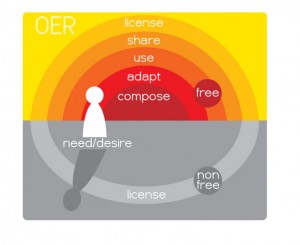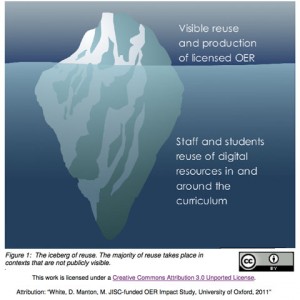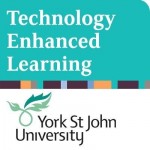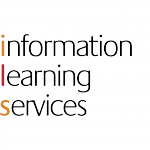| Activity | Time Required (approx) |
| Blog post | 6-8 minutes |
| Activity | 10-15 minutes |
Yesterday we introduced Open Education generally. Today, we’ll look specifically at an overview of Open Education Resources. By the end of the post, you will:
- understand what OER are
- be aware of their benefits for different stakeholders
- know some places to begin searching for OER for use in learning and teaching
What are OER?
The term OER was first used during a 2002 UNESCO workshop on open courseware in developing countries, but the Hewlett Foundation’s definition is the most widely referenced:
OER are teaching, learning, and research resources that reside in the public domain or have been released under an intellectual property license that permits their free use and re-purposing by others. Open educational resources include full courses, course materials, modules, textbooks, streaming videos, tests, software, and any other tools, materials, or techniques used to support access to knowledge. (The William and Flora Hewlett FOundation, Open Educational Resources).
In other words, they are any resources for learning and teaching that can be used by students and educators without needing to pay royalties or licence fees.
It’s useful to consider the distinction between ‘Big OERs’ (institutionally produced as part of large projects) and ‘Little OERs’ (individually produced, low cost). Martin Weller (2010) describes how the two differ in terms of quality and intention. Big OERs are created specifically for learning and teaching, are usually of high quality and produced with specific learning outcomes in mind, whereas Little OERs can be produced by anyone, shared and discovered anywhere – not just educational portals – and are not necessarily tailored to a specific teaching need.

The common thread is the resource’s adherence to Wiley’s ‘5R framework’ mentioned in Day 1:
- Retain – the right to make, own, and control copies of the content (e.g., download, duplicate, store, and manage)
- Reuse – the right to use the content in a wide range of ways (e.g., in a class, in a study group, on a website, in a video)
- Revise – the right to adapt, adjust, modify, or alter the content itself (e.g., translate the content into another language)
- Remix – the right to combine the original or revised content with other open content to create something new (e.g., incorporate the content into a mashup)
- Redistribute – the right to share copies of the original content, your revisions, or your remixes with others (e.g., give a copy of the content to a friend)
This material was created by David Wiley and published freely
under a Creative Commons Attribution 4.0 licence at:
http://opencontent.org/definition/

White and Manton’s (2011) report on ‘OER: the value and reuse in higher education’ liken OER reuse in institutions to an iceberg: only a small amount of highly visible, properly licensed and branded OERs exist above the surface, at institutional level, but below the water at course-level, staff and students are regular users of digital resources without considering their practice. So how are OER created? Everybody’s processes will vary but any OER lifecycle begins with a desire or need to learn or teach something. The following sequence of steps illustrates a typical development process.
OER Lifecycle
- Find: start by looking for suitable resources which contribute to meeting the need or satisfying the desire. This may include using general search engines, searching specific repositories and finding individual websites. Some potential components may be available offline, including last year’s lecture notes, class projects, handouts for learners and other resources prepared previously.
- Compose: with a collection of resources at your disposal, start piecing them together to form a learning resource for yourself, your fellow educators and/or learners. This is a creative design process of building an educational resource from scratch and/or using components you have found.
- Adapt: while composing OER, it will nearly always be necessary to adapt components to your local context. This may involve minor corrections and improvements, remixing components, localization and even complete rework for use in diverse contexts.
- Use: the actual use of OER in the classroom, online, during informal learning activities, etc.
- Share: once an OER is finished, make it available for the open education community to re-use and begin the life cycle again.
This material was produced by the Center for Open and Sustainable Learning and
available under the Creative Commons Attribution Share Alike licence at:
http://wikieducator.org/OER_Handbook/educator_version_one/Introduction/OER_life_cycle
Licensing plays a role throughout the life cycle. OERs will usually display a licence detailing if and how they can be used. Creative Commons is one of the most commonly used licence forms. The most open Creative Commons licence is CC-0 which allows you to reuse and adapt a resource for any purpose, without a requirement to reference the original creator. Other CC licences require you to attribute the author and provide a link to the original work and/or a description of the licence wherever you make the resource available. If a resource does not have a Creative Commons (or similar) licence permitting its reuse, you should assume that usual copyright restrictions apply. Tomorrow’s post will introduce the different Creative Commons licences in more detail.
Why are OER important?
The OER Research Hub ‘OER Evidence Report 2013-2014’ synthesises results from 6,000 responses to 20 surveys about the impact of open educational resources. 79.5% of responding educators use OER to get new ideas and inspiration (OERRH) but many, varying drivers exist for different user types. A significant contribution of JISC’s UKOER (2009-2012) programme was in articulating and providing evidence of benefits across a range of educational contexts and for a diverse mix of stakeholders across several sectors. The table below provides a summary of the benefits found in their studies:
[gview file=”http://blog.yorksj.ac.uk/moodle/files/2016/03/Benefits-of-Releasing-OER.pdf”]
Where can you find OER?
Knowing where to find resources is one of the biggest barriers for educators using OER. Perhaps the simplest way to find OER, particularly ‘Little OERs’, is using Google’s Advanced Search feature, which allows you to filter your search by usage rights. Google’s usage rights filter shows you images, text, videos that are either labelled with a Creative Commons or similar licence, or are in the public domain. The Center for Open Educational Resources and Language Learning provide a helpful infographic (below) on finding OER by using the cross-platform Creative Commons search.
[gview file=”http://blog.yorksj.ac.uk/moodle/files/2016/03/finding-oer-infographic.pdf”]
If you prefer to browse catalogued or curated OER, hundreds of dedicated initiatives exist worldwide, with tools and services to enable sharing and collaborative production of learning resources. Below is just a sample of some of the largest cross-disciplinary OER projects:
- MIT OpenCourseWare (OCW) is a repository of nearly all course content used in teaching at Massachusetts Institute of Technology. It features openly available materials from 2,260 courses, which tutors can use, adapt and share with their students within the core curriculum or as a useful supplement. Read more about Getting Started with OCW or browse the resources by department.
- OER Commons is an initiative created by ISKME (the Institute for the Study of Knowledge Management in Education) and supported by OER advocates, the William and Flora Hewlett Foundation. It hosts free-to-use teaching and learning content from around the world, organised by level of teaching, material type and subject. It also features several curated collections by topic.
- Openstax (previously Connexions) features tens of thousands of pages of content, available individually but also organised into thousands of open, fully reusable and adaptable textbooks in a host of different disciplines. All are downloadable across devices. The site is supported by Texas-based Rice University and philanthropic grants.
- MERLOT: Multimedia Educational Resource for Learning and Online Teaching (MERLOT) originated as a project from California State University in 1997. Unlike OERs in many other collections, all MERLOT materials are evaluated in some way to ensure that they are useful for the MERLOT community. This process is led by an editor and includes editorial board members and peer reviewers. MERLOT’s search of over 40,000 materials is open to all, but MERLOT also provides additional services around its content to registered users, including option to create a Course ePortfolio of bookmarked OER content from its site, contribute your own OERs or become a peer reviewer. Registration is free.
- TEMOA is a multilingual, cross-disciplinary OER portal similar to the OER Commons above. It originated from a UNESCO funded project at the Mexico-based Tecnologico de Monterrey. Read their Frequently Asked Questions or search or browse their collections to get started.
- LORO (Langauges Open Resources Online) contains resources for language learning and teaching. The site is maintained by the Department of Languages at The Open University. Most materials are OER available to download, reuse, revise etc. but check the licence type, as some do not allow edits to the resource.
Reusing existing content, assignments, modules etc. in your teaching relies upon your role as expert evaluator of information and content. You’ll need to consider the re-usability (are there any time or format limitations to reusing the resource?), the relevance, quality, accuracy and the impact of the resource. If you’d like to know more about the issues to consider when reviewing an OER, the University of Leicester’s OTTER project produced suggested quality criteria for evaluating the content itself, its openness, its suitability for reuse and re-purposing.
Reference resources…
The OER Handbook for Educators, produced by the Center for Open and Sustainable Learning, provides a guide for getting started in the creation of OER. The primary chapters are on Finding, Composing, Adapting, Using, Sharing and Licensing OER.
JISC OER Guide (2014) explains OER but also addresses the surrounding issues for different educational stakeholders: senior managers, learning technologists, technical staff and educators interested in releasing OERs.
The OERRH OER Evidence Report 2013-14 is the first report from the OER Research Hub – a network of researchers and projects dedicated to answering the question ‘What is the impact of OER on learning and teaching practices?’
Open educational resources in higher education: A guide to online resources. A blog post by Goldberg, E. J. & LaMagna, M. (2012) on the Association of College and Research Libraries website featuring a list of OER repositories and portals.
Activity
Choose two of the OER repositories or websites linked to above. Compare and contrast the usefulness of the two repositories. Some questions you might consider:
- Can you find anything relevant for your teaching?
- Are the resources up-to-date and well organised?
- Is it clear what licence has been applied to the resources, i.e. what you can legally do with them?
- How easy does the site make it to retain, reuse, revise, remix, redistribute its resources?
Add your thoughts in the comments section below – we advise a minimum of approximately 50 words and max of 200.
Complete at least three activities across the five days to earn our ‘Open Education Enthusiast’ badge.
Still to come…
- Day 3: Creative Commons Licensing: know your SA from your ND!
- Day 4: Introduction to Open Access Publishing
- Day 5: Becoming an Open Educational Practitioner
Don’t forget to follow us on Twitter at @YSJTEL and @YSJ_ILS or search the hashtags #YSJOpenEd and #OpenEdWeek for additional materials or comment.
Róisin Cassidy (Technology Enhanced Learning),
Ruth MacMullen, Ruth Mardall and Clare McCluskey-Dean (Information Learning Services)
| <<< Day 1: What is Open Education? | Day 3: Creative Commons Licensing: know your SA from your ND! >>> |
4 responses on "5 Days of Open Education - Day 2: The ‘what’, ‘why’ and ‘where’ of Open Educational Resources (OERs)"
Leave a Message
You must be logged in to post a comment.



MIT is a useful tool as it is specific to a group of individuals however looking at the OER Commons there is more information on it and is not only specific to a group of individuals. The resources seem up to date and they would have to be for MIT as course programmes change/alter all the time. Both websites detail the Creative Commons Attribution allowing the individual to reuse and adapt a resource for any purpose, without a requirement to reference the original creator. OER Commons also carries out in person and also virtual OER workshops which I think adds a little more and may be suitable for different types of learners.
OER Commons offers a simple homepage that let the user easily search for content. The result page offers easily identifiable filters, including ‘conditions of use’ (licence). Results can be sorted based on multiple criteria including ratings. OER Commons also offers ‘learner options’ to cater for users’ special needs.
At first, the MIT OCW is a more complicated platform, with featured resources displayed on the homepage. The course finder is accessed via the menu bar and allows the user to shortlist courses via topics and sub-topics. Results are displayed in a list format, only offering the level of the course, its title and number. There is no obvious mention of the licence applied to each resource but by clicking on the ‘cite this source’ button the user gets access to the Terms of Use of the materials.
Whilst OER Commons is easier to use and clearly states the licences applied to each resource, both platform offer a vast choice of materials. Both platforms are only available in English but OCW lists translated courses, allowing resources to be seen and used by a wider population worldwide. It appears that the use of each platform will depend on the resource that one is looking for.
I really like the OER Commons site – as previously mentioned, it is easy to use and the search facility is very easy and clean. It is relevant for my practice since there are items on here from all levels of teaching and learning, so I can search for resources which are for higher education, but also for mathematics in primary school which is what I tutor in. The licensing is clear in the search option. This is one which I will continue to use.
MIT open course ware
Well organised materials and useful course finder. It was quick and easy to locate course materials on media studies. Indeed, there were several sources that were relevant to the modules I teach. What was particularly useful was the ways in which various search filters could be used to refine searches such as searching according to video/audio lectures, or textbooks. The site also made it clear how materials could be re-used and re-distributed via the Creative Commons License.
OER
The drop down menu was split into main disciplines such as ‘Arts and Humanities’ which was useful. The additional search facility such as searching according to education levels was also useful. The conditions of use were also clear. However, what was less clear was how to find information that was relevant to media and film studies. For instance, in the category ‘arts and humanities’ there were no sources that were specifically about media or film studies. Nonetheless I did find some useful information such as open textbooks on marketing and advertising which are relevant to a module I am currently teaching.
Merlot
The search facility was very useful and I soon found information about media studies that was highly relevant to the modules I am teaching. For instance, I found a recent media and cultural theory textbook and a set of case studies on social media. The site also included clear information about use-re-use and distribution.